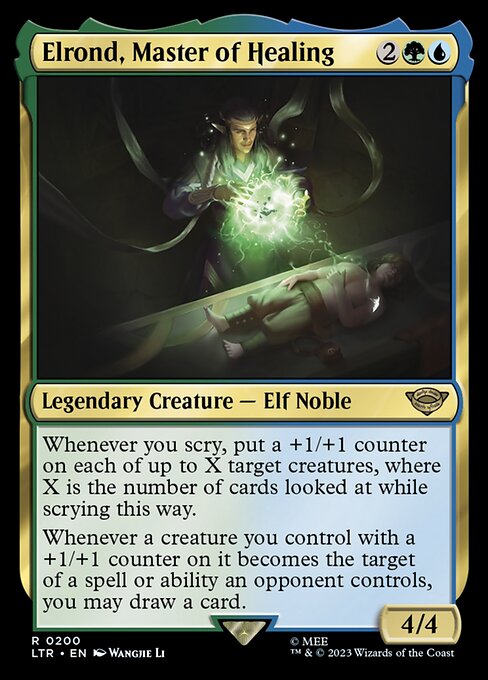
Image courtesy of Scryfall.com
Elrond’s Role Across Realms
When you dip into The Lord of the Rings: Tales of Middle-earth, you’re not just drafting a card—you’re stepping into a narrative handshake between two vast worlds. Elrond, Master of Healing embodies that bridge beautifully. With a green-blue (G/U) color identity, this legendary Elf Noble brings a strategic blend of resourcefulness, resilience, and evergreen growth. The mana cost of {2}{G}{U} places him in the coveted midrange-green-blue space, where card selection, tempo, and board presence dance together like elves at a Rivendell feast 🧙♂️. The design invites players to lean into scry, counterplay, and long-game value—hallmarks of both Elvish cunning and blue’s calculated precision 🔥.
Beyond the glossy art and fanservice, the intertextuality here is a masterclass in M:tG storytelling through mechanics. Elrond’s role as a healer and advisor in Middle-earth becomes a proactive engine in your command zone: every scry you perform becomes not just a look ahead, but a way to fortify your board. The result is a card that rewards foresight—the kind of foresight fans have delighted in since the days of preordains and ponderings—while also offering a powerful payoff that scales with your planning. It’s a love letter to both Tolkien’s lore and MTG’s love of layered strategy 🧭🎨.
Mechanics that Echo Tolkien’s Worldbuilding
Elrond’s abilities hinge on two elegant triggers that feel almost ritualistic in a high-level match. First, Whenever you scry, put a +1/+1 counter on each of up to X target creatures, where X is the number of cards looked at while scrying this way. This means your top-deck discipline directly translates into a growing army. Scry 1: one creature grows; Scry 3: up to three creatures get bigger. It’s a gentle reminder that in Middle-earth, knowledge is power—sometimes the most potent force is knowing which creature to empower next. It also encourages you to curate a board that can weather tempests and scale in response to your strategic foresight 🧙♂️💎.
Second, whenever a creature you control with a +1/+1 counter on it becomes the target of a spell or ability an opponent controls, you may draw a card. This is the liftoff moment: your buffed creatures become valuable, protected assets that reward you for thoughtful positioning. If your opponent answers with targeted removal, you’re not just losing a blocker—you’re drawing a card to recover and refine your plan. It’s the kind of layered interaction that makes every match feel like a chess game where your pieces are secretly training with Legolas and Gandalf in the background ⚔️. The synergy between counters and card draw turns a mere evasive swing into a sustained engine of advantage.
Design, Lore, and Collectibility
Artist Wangjie Li brings Elrond to life with a composition that feels both regal and intimate—the Elven lord who has spent ages balancing diplomacy and defense. The set—The Lord of the Rings: Tales of Middle-earth (LTR)—is a draft_innovation that leans into Universes Beyond storytelling, bridging J.R.R. Tolkien’s world with MTG’s ruleset. The rarity is rare, and the card is legal in formats including Commander, Modern, Legacy, and Vintage depending on official rulings and multiverse interactions. In practical terms, Elrond’s kit fits nicely into a blue-green shell that loves to control the pace and then pivot into a robust, counter-backed board state. And while his price tag on paper may be modest (the card’s value hovers in a budget-friendly range for most constructed play), the real premium is in the narrative payoff and the feel of piloting a card that nods to a legend while delivering modern value 🧪🎲.
From a design perspective, the pairing of blue’s selection with green’s growth—monetized through scry counters—feels like a deliberate recursion of MTG’s long-standing affinity for player-driven board development. The “look ahead” mechanic invites you to consider not just the next turn, but the turn after, echoing Elrond’s own centuries-spanning counsel. It’s a reminder that MTG can be slyly literary: a single card can conjure a memory, a scene, and a future outcome all at once 🔮🎨.
Playstyle Notes: Building with Intention
If you’re piloting Elrond in a Commander table or a tiered green-blue deck, lean into resilience and card advantage. Pair him with enchantments or creatures that benefit from +1/+1 counters, or with effects that let you scry more efficiently so that “X” climbs quickly. A built-in engine emerges: the more you scry, the more your board grows; the more your creatures grow, the more likely your buffs will translate into big, late-game swings. And because the second ability rewards you for being targeted, you can lean into a defensive posture—shielding your bigger threats while your opponent explores their removal suite—and still come out ahead on cards. It’s a nuanced dance of tempo and inevitability 💎🧙♂️.
To fans of cross-media storytelling, Elrond is a hands-on illustration of how MTG can carry a shared mythos into its own ruleset. The card becomes a talking point at your table: what does it mean to heal in a deluge of spells? How does a healer’s presence alter the tempo of a game when the threat is not just board state but narrative resonance? These are the questions that turn a casual night into a story you’ll recount long after the last duel fades away ✨.
And if you’re looking for a small boost to your setup while you dive into intertextual strategy, consider upgrading your desk with a stylish mat that keeps pace with your playstyle. It’s a practical nod to the culture you love—plus a chance to keep your cards crisp and your workspace tidy during long sessions 🧙♂️🎲.
Custom Mouse Pad 9.3 x 7.8 Non-Slip Desk Mat
More from our network
- https://crypto-acolytes.xyz/blog/post/parallax-opens-indirect-metallicity-view-for-distant-hot-giant/
- https://blog.digital-vault.xyz/blog/post/understanding-ga4-reports-a-beginners-practical-guide/
- https://blog.digital-vault.xyz/blog/post/using-embeddings-to-cluster-sea-gate-wreckage-and-similar-mtg-cards/
- https://blog.digital-vault.xyz/blog/post/tranquil-frillback-sparks-crossover-interest-for-non-mtg-collectors/
- https://blog.digital-vault.xyz/blog/post/why-dawnray-archer-exemplifies-its-color-pie-philosophy/